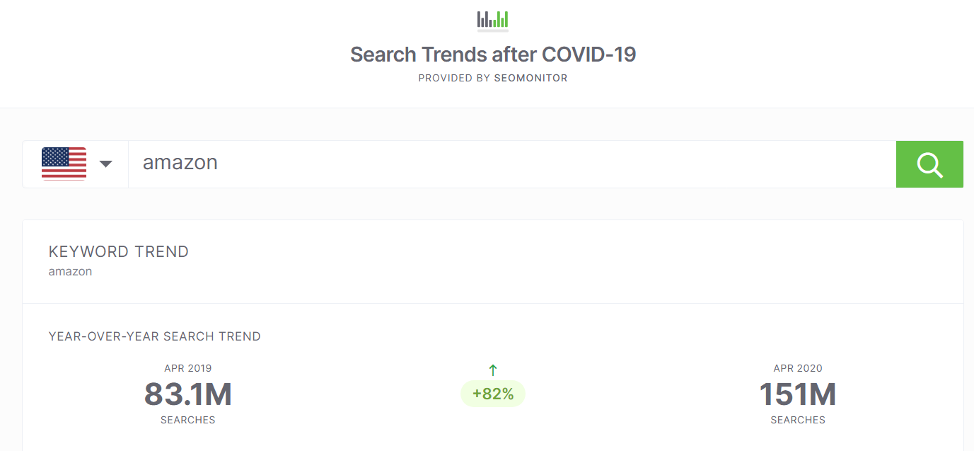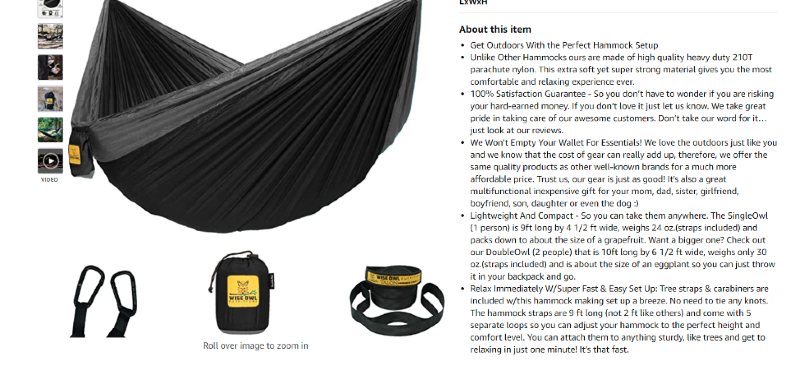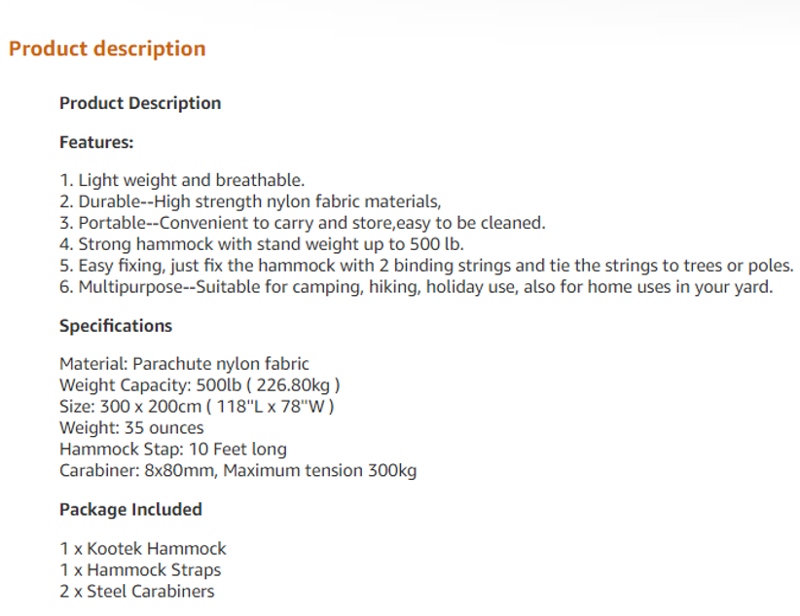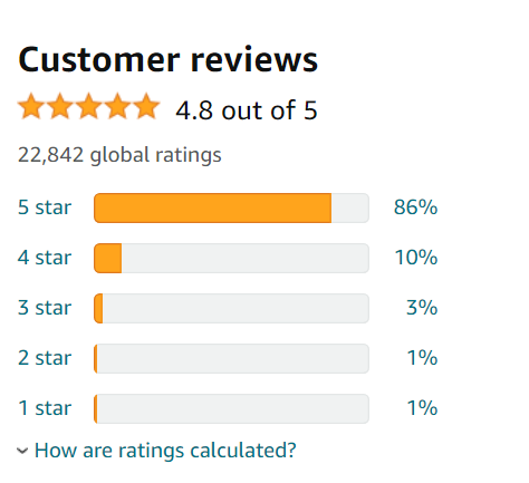Amazon is one of the largest online retailers worldwide and the largest online retailer in the United States. In 2019, net sales on Amazon reached more than US$280.5 billion, up from US$232.89 billion the previous year. On this platform, retailers sell books, clothing, electronics, music, and many other consumer products.
The company is also the maker of the world's most popular e-book reader, the Amazon Kindle.
The majority of Amazon's revenue is generated by sales of electronic products, followed by third-party sales services and AWS (Amazon Web Services). Although it operates mainly in the B2C market, Amazon also allows third-party sellers to sell their products, as well as to provide enterprises with technological infrastructure services (services that guarantee saving resources, eliminating maintenance costs, increasing the quality of data management, enhancing information security, and delivering quality services for citizens and the business environment).
Amazon Web Services includes cloud computing and hosting services, which is a growing sector of online business services. AWS is one of the most popular public cloud platforms and infrastructure services worldwide, with 63% of respondents in a global survey indicating that they were already running applications on the AWS platform.
Still, let's take a look at the 9 most fascinating statistics Amazon sellers need to know:
- 9 out of 10 consumers check the product price first on Amazon (source).
- 2% of Amazon Echo device owners have made purchases via Alexa (source).
- Amazon sells over 12 million products (source).
- Amazon sells over 1.1 million home improvement products (source).
- 95 million Americans are Amazon Prime members (source).
- $1.4K is the average annual spending of Amazon Prime members (source).
- FBA gives sellers 30-50% more sales (source).
- In 2017, Amazon shipped more than 5 billion items worldwide (source).
- Over 50% of all sales on Amazon are from third-party sellers (source).

Is Amazon taking over the world? Well, it turns out that every second American spends more than half of their paycheck on Amazon Prime! Whether you need to stock up on home goods, appliance accessories, or sports equipment, you'll find it hard to pass up the affordability that Amazon offers.
We have created this guide to introduce you to the search engine algorithms behind the Amazon platform and to give you relevant advice on optimizing your listings (ads).
Definition: Amazon SEO
Amazon SEO is the process of optimizing your product listings to rank better in Amazon searches for the right keywords. When you optimize your product listing, you make it easier for Amazon to find your products and show them to shoppers who are looking for something similar.
How does the listing ranking work in Amazon's search engine?
Amazon Sales Rank is a reverse ranking system. This means that a product that generates the lowest sales ranks last, while a product that achieves the best sales is at the top of the search results.
While many Amazon users and experts are still trying to figure out what determines sales ranking, there are three important things every Amazon seller should know about how search works on the platform:
- Like Google, Amazon has a search engine. This means that SEO needs to be emphasized this time as well.
- Potential buyers will search for your product before finding it among similar ones, so improving product visibility becomes crucial. This is exactly where Amazon SEO comes in. With the right Search Engine Optimization strategies for Amazon, you not only improve your ranking but also generate more sales.
- Just as you are looking for solutions to improve your visibility on Amazon, so are your competitors in the Amazon charts, but more agile. So, it's time for you to do it too.
Every Amazon retailer knows the importance of their search engine, and how a product appears higher on the results page is crucial to a successful business. Products that do not appear on the first page of search results will practically not be seen by potential buyers. In addition, some buyers don't even go beyond the first three listings.
So most of the sales are made through the front page.
This demonstrates how vital it is to optimize a product listing for the latest Amazon A9 algorithm.
What is the Amazon A9 algorithm and how does it work?
Definition: A9 is Amazon's product ranking algorithm that displays results based on keywords or key phrases entered into the search box. The results displayed are powered by previous customer purchases, purchasing preferences, and several other factors.
The algorithm chooses which products to display in front of potential buyers and how high these products can be ranked based on criteria such as:
- Relevance to search queries (keywords entered in the search box)
- Customer preferences and past behavior
- The number of previous purchases for a particular product.
Apart from those mentioned, there are a lot of other factors. Because A9 is a "secret" algorithm within Amazon, its functionality cannot be known precisely. The given algorithm could be worth millions and millions of dollars. So, the confidentiality of how it works is well-kept by the company's developers. But with a few "experiments" you can get an idea of how it works.
We have aimed to make this task easier for you and come up with our observations and advice in this regard.
What Factors Influence A9 Search Rankings?
Amazon A9 ranking factors are classified into two important groups:
Explicit factors
- Price – a much higher price than your competitors can prove to be a disadvantage for your product.
- Stock supply – any product that is no longer "in stock" can also become a disadvantage. Your ad's positions may drop, or worse, it may disappear from the SERPs.
- Text Relevance – This indicates how well you have optimized your product listing with the right title and description.
Default Factors
- Selling Velocity – the more products you start selling, the higher the chances of your product ranking higher and becoming successful on Amazon.
Now let's take a closer look at product optimization on Amazon.
What do you need to know about Amazon SEO?
Amazon wants to give its customers a great shopping experience. A happy user will keep coming back to buy more products. Therefore, Amazon SEO includes both search engine and shopper optimization.
Amazon's key factors fall into two distinct categories:
- Desirability (the ability to generate the burning desire to buy)
- Discoverability (the ability to generate the desire to discover).
What factors fall into the category of "Desirability?"
The factors that influence the willingness to buy are primarily about the user and their experience on Amazon.com. Therefore, this shows how well a user converts once they are on your product page.
The following data are included in this category:
- Attractive product images
- Optimized product title, which would increase the click-through rate
- Competitive price of the product
-Positive product reviews and ratings
- Product description in clear bullet points
- Communicating how your product is different from your competitors.
What factors fall into the category of "Discoverability?"
Compared to the factors of "desirability", the factors of "discoverability" do not target the user. Instead, it primarily addresses indicators that evaluate how a product is displayed and the likelihood of its purchase.
It is obvious that Amazon ranks the most profitable product with a good conversion rate at the top, considering that they include several factors such as:
-Fulfillment Program (FBA)
-Price
-Availability in stock
- Shipping costs
- Keyword optimization.
Amazon SEO: How to Improve Your Product Ranking on Amazon?
I have prepared 9 steps for you to take to systematically improve your results and have as many sales as possible:
Step 1: Product title
The most important factor to focus on to increase product visibility and ranking is the product title. Make sure it contains all the information relevant to the product you are selling.
According to Amazon, a product title should include the following:
- Brand name
- The name of the product
- The material from which it is made
- The size
- The weight
- Color
- One advantage (choose the most important one!)
See an example below:

Note: On Amazon, a product title is limited to 200 characters. This doesn't mean you can stuff it with lots of keywords. Use only the ones that are highly relevant to your product.
Never overload your headlines with keywords as this will not attract potential buyers at all. Opt for clarity and naturally insert keywords.
On the other hand, extremely short headlines often have lower Click Through Rates (CTRs). The brand name appears on the product page and should always be specified, as many users search for specific brands on Amazon.
Make sure you use 2-3 keywords that not only have a high search volume but also "explain" the product. In addition to increasing the search ranking, the correct product title influences the conversion rate and the click-through rate.
Therefore, make sure that the first 5-6 words of the title are clear, concise, and easy to read. These little things make the title attractive to the user and optimized for Amazon search.
Step 2: Analyze product-relevant keywords
Select the best keywords for the product(s) you are selling. A perfect way to do this is to look at the best-selling products in the category they belong to. Analyze them and extract the most relevant keywords.
Choose the top 4 or 5 products with the best ranking and the ones that have extremely good reviews. Scroll through the list and search for keywords that match your product. Yes, the process can be quite time-consuming, but to save your time and energy, we recommend that you opt for Amazon Keyword Research - a free tool that helps you discover keywords on Amazon in different niches.

Now you have the perfect set of keywords to work within your product listings! What's next?
- Having the list of keywords, and measuring their potential to bring traffic. Analyze the search volume of these keywords to gauge the size of the potential online market.
- Write quality content based on selected keywords. By inserting some inspirational words, you can immediately connect with potential customers and respond to their needs.
- By evaluating how your customers search and what keywords they enter in the search box, you get an idea of their needs and how to best meet them.
Step 3: Product Price
Whenever you set prices for your products, be sure to check your competition's prices (for all variations of that product). Differences that are too big will not play in your favor. Try to come up with a similar price or, if you have room to maneuver, even lower them.
Step 4: Product photos
It is said that "a picture is worth a thousand words", and this becomes very evident when talking about attracting potential buyers on a platform like Amazon.
Never underestimate the power of images. They represent one of the most essential selling factors. Although they do not directly affect Amazon SEO, they have a significant impact in reducing the bounce rate of the listing.
Moreover, with the "Zoom" feature for images, customers can take a closer look at the products. This means that you should use HD (high-definition) images and much better resolution than other e-commerce sites.
Note: Amazon recommends using larger images - at least 1000 pixels in width or height to enable the "Zoom" feature.
You probably already know that every shopper who lands on Amazon.com wants to be presented with as clear a picture of the product as possible before making a purchase.
If there are only a few images available, that have poor resolution, they may not be interested in your product even if it is cheaper than competitors. Therefore, invest in making high-resolution images (between 1000 × 1000 pixels / 1500 × 1500 pixels).

Step 5: Amazon Product Features in Bullet Points
Since Amazon offers a lot of space in the "About this item" section, you have the opportunity to develop an attractive description and emphasize the benefits of the product very convincingly.
Presenting the product description in long paragraphs can have two disadvantages, which include:
- Descriptions may not appeal to potential buyers because they are unclear, unapproachable, and confuse - meaning their placement will not only reduce conversion rates or sales but also visibility and purchase speed.
- The Amazon A9 algorithm hates blocks of text that do not contain numbers or highlights. Instead, it prefers to be in the form of bullet points with an improved, easy-to-understand, and more organized look.
Again, you should be careful not to overload your description with keywords, but instead emphasize specific product features such as size, weight, and color, as this is how keywords are naturally inserted.
If the potential buyer hasn't found a solution to their problem in the first 1-2 paragraphs, you've lost them! This will increase your bounce rate, which in turn can hurt your rankings.
Step 6: Product Description
Apart from the other key aspects already mentioned, the product description also serves to convince the buyer to make the purchase. So it is important to highlight the positive features of the product and expose them as practically as possible.

Although the product description is not as strong a ranking factor as the product title or bullet points, it still has good relevance for the purchase decision. This is also where the right keywords should be placed. In addition, don't forget to focus your efforts on emotional triggers.
Step 7: Product availability
Make sure your product is in stock and you won't have an empty warehouse as this can also negatively impact your ranking.
If you use Amazon FBA, you can set automatic notifications to let you know whenever the inventory is running low.
On the other hand, if you sell the product on various e-commerce sites, use stock synchronization platforms to be able to monitor the inventory so that it does not run out unexpectedly.
However, if you source, store, and ship independently (if you don't use Amazon's warehousing service), make sure you have all variations in stock and are always in touch with your suppliers. This will help you avoid product shortages.
Step 8: Amazon Back-end keywords
Back-end keywords are keywords that only the Amazon A9 algorithm perceives and sees. Therefore, they can have a positive impact on the search for a product.
The important things to keep in mind at this step are as follows:
- Keywords or terms that you could not fit into the product description or title.
- Spelling mistakes in product writing (which customers tend to make more and more) or product keywords.
- Keywords translated into Spanish or French, as there is a large percentage of the Spanish-speaking population in the United States.
- Other synonyms that buyers might be looking for.
In the image below, you notice 2 spaces where you will include your back-end keywords:
- Search Terms (those mentioned above)
- Platinum Keywords (keywords intended for well-known brands positioned well on Amazon, helping them create their online store homepage).
As a rule, platinum keywords are ignored by brands that have just launched on Amazon because they do not influence their position in the search results.

Remember: Do not repeat keywords too much in the listing or the back-end section, as a higher frequency of using a particular keyword does not affect ranking.
Step 9: Product reviews and rating

When it comes to Amazon SEO, a product's rating and reviews are still a very relevant component. These are evaluated and taken into account for better ranking. At the same time, reviews also help to indirectly improve the ranking. Where else do you put it that influences the click rate and conversions?
The more positive reviews, the better the value of the product. This is also reflected by the ratings of other users and buyers, who may find customer reviews helpful or unhelpful.
In this chapter, brands tend to improve their Customer Care services and if the buyers are not satisfied with the product, it is returned and another product is delivered from the available stock. It's a must-have and respected practice by brands that want sales and loyal customers, even if it doesn't directly impact SEO results.
Conclusion: Amazon SEO and its A9 algorithm
Optimizing the product listing correctly will make the desire to buy and discover the product close to 80%. But the improvement process does not end there. Keeping up with trends, algorithm updates, and continuous optimization is the strategy you need to stay on top of Amazon search results.
We hope this guide helped you learn in detail how the Amazon A9 algorithm works and how to optimize your ads so that they get you visibility on Amazon and, of course, sales!
Phone: +373 69 809 235
Email: info{@}seolitte.com
